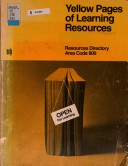"The city is education," this book proclaims. "The city is education--and the architecture of education rarely has much to do with the building of schools. The city is a schoolhouse, and its ground floor is both bulletin board and library. The graffiti of the city are its window displays announcing events; they should reveal its people to themselves, telling about what they're doing and why and where they're doing it. Everything we do--if described, made clear, and made observable--is education: the 'Show and Tell, ' the city itself.... It is a classroom without walls, an open university for people of all ages offering a boundless curriculum with unlimited expertise. If we can make our urban environment comprehensible and observable, we will have created classrooms with endless windows on the world."The book resembles the phone company's Yellow Pages, but the intent is not to "let your fingers do the walking"--the book is meant to lead you out into the environment, to put you into contact with a lot of different kinds of people, to teach you the what, where, why, and how-to of all sorts of things that go on in the real world. The intent, finally, is to led your head do the thinking, your eyes do the seeing, and--it's good exercise--your feet do the walking...".The city is everywhere around us, and it is rife with learning resources. Even more than classrooms and teachers, the most valuable learning resources in the city are the people, places, and processes that we encounter every day. But in order to realize the vast learning potential of these resources, we must learn to learn from them.""Yellow Pages of Learning Resources" is a guide to the city--any city, any town. It consists of some seventy alphabetically arranged categories and tells us how to tune them in and why they are important to know about. It is a specific guide to people (the pharmacist, the taxicab driver), to places (the airport, the courtroom), and to processes (candy making, city planning). Here are some others: architect--bricklayer--cemetery--dry cleaner--electrician--food distribution center--garbage man--hospital--insurance company--junk yard--kindergarten room--locksmith--museum--next-door neighbor--orchestra member--paper box factory--quarry--real estate broker--social worker--tree stump (tree stump?)--union boss--vacant lot--weather forecasting--x-ray technician--Yellow Pages Telephone Directory--zoo.Any number of other possibilities can be thought of by students and teachers, and they can then be sought out once the book has made it clear how to get around. "Student" here can be anybody--while the book is within the range of school-age kids, it is also open to adults, except those who already know how locks work, who the next-door neighbor is, and what ward leaders "really" do. They are excused from class and are free to go out and learn something new on the way home or "at" home 9like, why doesn't the furnace thermostat work?).Some of the resources listed are also especially suitable for group learning experiences, and thus the book becomes a valuable tool for the teacher, parent, boy or girl scout leader, or adult education group leader.
- ISBN10 0262230615
- ISBN13 9780262230612
- Publish Date 22 November 1972
- Publish Status Out of Print
- Out of Print 18 September 2010
- Publish Country US
- Publisher MIT Press Ltd
- Imprint MIT Press
- Format Hardcover
- Pages 70
- Language English
